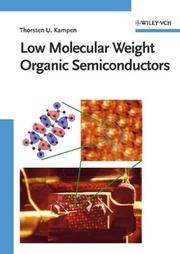| Listing 1 - 10 of 81 | << page >> |
Sort by
|
Book
ISBN: 3527410538 9783527410538 Year: 2012 Publisher: Weinheim: Wiley-VCH,
Abstract | Keywords | Export | Availability | Bookmark
 Loading...
Loading...Choose an application
- Reference Manager
- EndNote
- RefWorks (Direct export to RefWorks)
Dissertation
ISBN: 3736931182 Year: 2009 Publisher: Göttingen, [Germany] : Cuvillier Verlag,
Abstract | Keywords | Export | Availability | Bookmark
 Loading...
Loading...Choose an application
- Reference Manager
- EndNote
- RefWorks (Direct export to RefWorks)
Book
ISBN: 3736918550 Year: 2006 Publisher: Göttingen, [Germany] : Cuvillier Verlag,
Abstract | Keywords | Export | Availability | Bookmark
 Loading...
Loading...Choose an application
- Reference Manager
- EndNote
- RefWorks (Direct export to RefWorks)
Book
ISBN: 3110473879 3110473631 9783110473636 9783110473872 3110473607 9783110473605 Year: 2016 Publisher: Berlin/Boston De Gruyter
Abstract | Keywords | Export | Availability | Bookmark
 Loading...
Loading...Choose an application
- Reference Manager
- EndNote
- RefWorks (Direct export to RefWorks)
In the field of organic semiconductors researchers and manufacturers are faced with a wide range of potential molecules. This work presents concepts for simulation-based predictions of material characteristics starting from chemical stuctures. The focus lies on charge transport - be it in microscopic models of amorphous morphologies, lattice models or large-scale device models.An extensive introductory review, which also includes experimental techniques, makes this work interesting for a broad readership. Contents: Organic Semiconductor DevicesExperimental TechniquesCharge Dynamics at Dierent ScalesComputational MethodsEnergetics and Dispersive TransportCorrelated Energetic LandscapesMicroscopic, Stochastic and Device SimulationsParametrization of Lattice ModelsDrift-Diusion with Microscopic Link
Book
ISBN: 9781620819760 1620819767 9781612093918 1612093914 Year: 2011 Publisher: New York
Abstract | Keywords | Export | Availability | Bookmark
 Loading...
Loading...Choose an application
- Reference Manager
- EndNote
- RefWorks (Direct export to RefWorks)
Book
ISBN: 9783540763130 3540763139 Year: 2008 Publisher: Berlin ; New York : Springer,
Abstract | Keywords | Export | Availability | Bookmark
 Loading...
Loading...Choose an application
- Reference Manager
- EndNote
- RefWorks (Direct export to RefWorks)
Book
ISBN: 9789180751322 9789180751339 Year: 2023 Publisher: Linköping : Linkopings Universitet,
Abstract | Keywords | Export | Availability | Bookmark
 Loading...
Loading...Choose an application
- Reference Manager
- EndNote
- RefWorks (Direct export to RefWorks)
This dissertation by Qingqing Wang explores the electronic structures of two-dimensional molecular crystals (2DMCs) and their correlation with properties, focusing on organic semiconductors. The study delves into the unique advantages of 2DMCs, such as long-range molecular packing and low defect density, which make them ideal for exploring structure-property relationships and developing high-performance optoelectronic devices. The work emphasizes the gap in understanding the intrinsic properties of organic single crystals compared to inorganic counterparts. The research utilizes advanced surface science techniques to investigate the electronic structure of organic materials like C6-DPA and perylene, highlighting their potential applications in organic electronics. The dissertation is aimed at researchers and professionals in the field of materials science and electronic engineering, seeking to advance the understanding and development of organic semiconductors.
Book
ISBN: 9789180751285 9789180751292 Year: 2023 Publisher: Linköping : Linkopings Universitet,
Abstract | Keywords | Export | Availability | Bookmark
 Loading...
Loading...Choose an application
- Reference Manager
- EndNote
- RefWorks (Direct export to RefWorks)
This dissertation by Xian’e Li focuses on the study of interfaces in organic solar cells (OSCs), highlighting their significance in electronic devices. Organic semiconductors, known for their lightweight, flexible, and tunable properties, have been critical in advancing OSCs, which now achieve efficiencies close to 20%. The research investigates energy level alignment (ELA) at various interfaces within OSCs, examining how these energetics influence device performance. The work identifies the pinning energies of newly developed donor and non-fullerene acceptor systems, exploring their impact on interface vacuum level shifts. Additionally, the thesis addresses the effects of environmental factors like water and oxygen on the work functions of organic films. The study concludes with recommendations for efficient charge-transport-layer-free OSCs, emphasizing simplified device structures for enhanced performance. The intended audience includes researchers and professionals in the field of organic electronics and materials science.

ISBN: 3527406530 9783527406531 Year: 2010 Publisher: Weinheim: Wiley-VCH,
Abstract | Keywords | Export | Availability | Bookmark
 Loading...
Loading...Choose an application
- Reference Manager
- EndNote
- RefWorks (Direct export to RefWorks)
"This up-to-date reference for students and researchers in the field is the first systematic treatment of the property measurements of organic semiconductor materials. Following an introduction, the book goes on to treat the structural analysis of thin films and spectroscopy of electronic states. Subsequent sections deal with optical spectroscopy and charge transport. An invaluable source for understanding, handling and applying this key type of material for physicists, materials scientists, graduate students, and analytical laboratories."--P. [4] of cover.
Book
ISBN: 0198528647 9780198528647 Year: 2010 Publisher: Oxford: Oxford university press,
Abstract | Keywords | Export | Availability | Bookmark
 Loading...
Loading...Choose an application
- Reference Manager
- EndNote
- RefWorks (Direct export to RefWorks)
| Listing 1 - 10 of 81 | << page >> |
Sort by
|

 Search
Search Feedback
Feedback About UniCat
About UniCat  Help
Help News
News